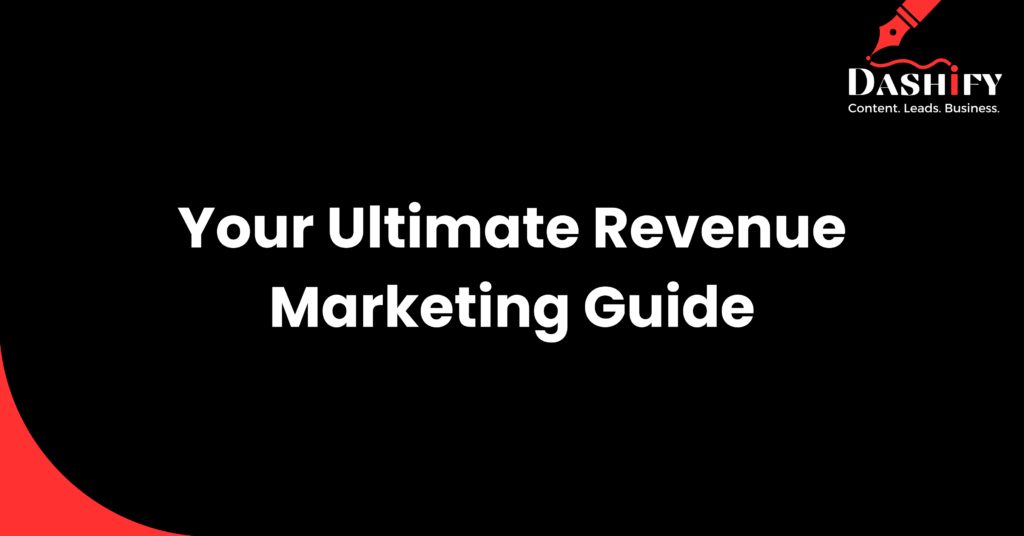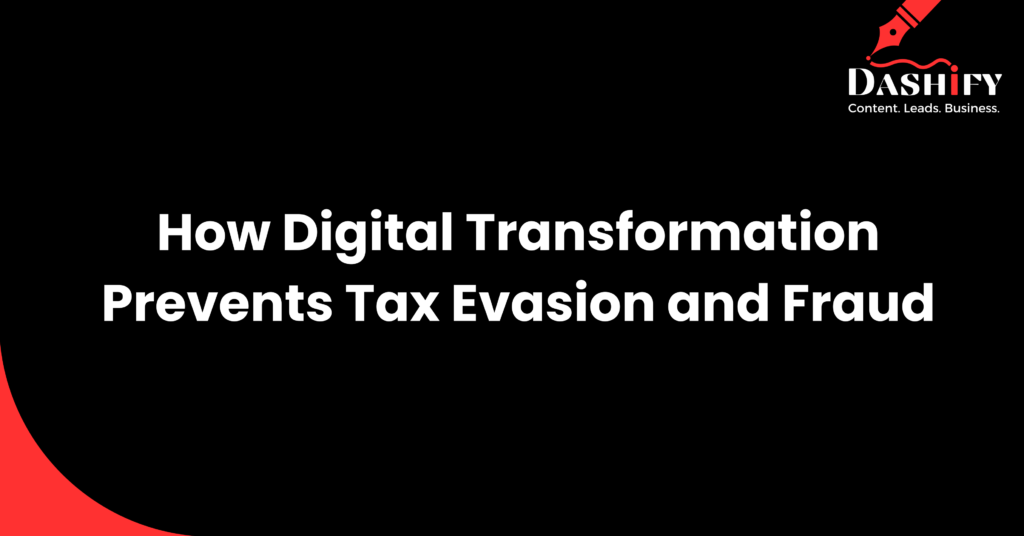You’re here to scale or build your B2B content strategy to beat the competition and achieve a relevant online presence.
But understand this first:
While 60% of consumers relish relevant brand content, a staggering 91% of email users unsubscribe from company emails.
This is why your business needs a content strategy tailored to your revenue marketing goals and target audience. And that’s exactly why —
- 90% of organizations leveraged content strategies in 2022
- 78% of Chief Marketing Officers envision custom content as the future.
Ankita Ahuja, Founder & Content Specialist at Content Brew, says, “Several businesses emphasize building a top-of-the-line content strategy because it’s no longer about stuffing keywords to rank on a search engine but about the content that defines their persona, vision, and business.”
Here’s her expert input on what goes behind brands prioritizing content strategies:
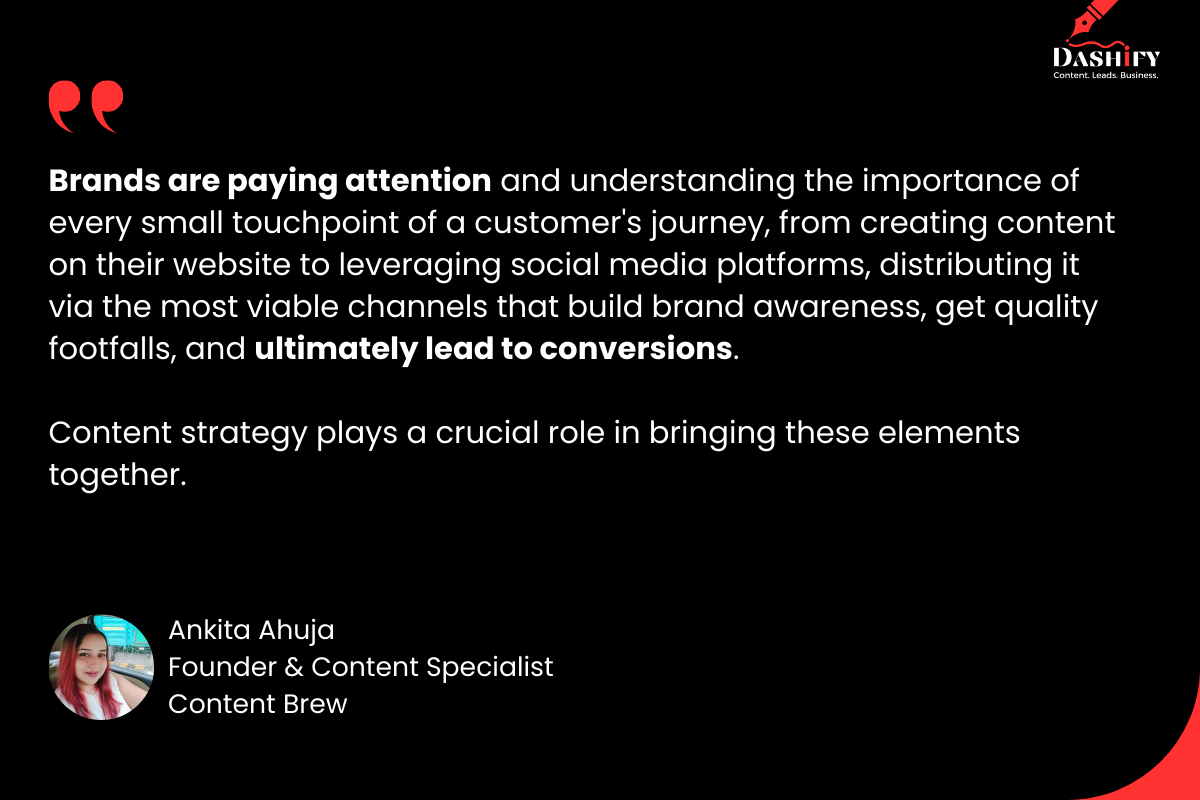
Let’s take you through the meaning, components, and process of building a B2B content strategy.
What is a B2B Content Strategy?
A B2B (Business-to-Business) content strategy is a plan that outlines how businesses can create, distribute, and manage wide-ranging content assets to attract, engage, and convert other businesses as their target audience.
It involves:
- Strategic decision-making to align content with business goals and the overall marketing strategy.
- Creating and delivering content that provides value and resonates with B2B clients.
- Content ideation, planning, distribution, and performance tracking.
What to Ensure Before Creating a Content Strategy? [Checklist]
Crafting an effective B2B content strategy requires a detailed framework, just like drafting a blog outline before writing a blog. Here’s a checklist before you start implementing a step-by-step process:
1. Are Your Business Objectives Clear?
Ensure your content strategy aligns with key business goals over the next 6 to 12 months.
Why: Understanding company objectives guarantees that content efforts directly contribute to desired outcomes.
Metrics: Establish metrics that gauge content performance in alignment with business targets.
2. Have You Researched Your Audience Well?
Knowing your target audience is vital for content marketing success.
Why: To go beyond basic demographics, exploring audience goals, pain points, and contextual insights.
Tailoring Content: Create content plans that genuinely connect with audience needs, ensuring relevance and efficient resource use.
3. Have You Documented Your Content Production Workflow?
Efficient content management is integral to an effective strategy.
Why: To address the content production process, covering creation, editing, organization, distribution, and promotion.
Roles: Clearly define responsibilities for writing, designing, editing, calendar creation, and distribution to streamline the workflow.
4. Have You Decided on Your Budget to Execute the Strategy?
A budget is imperative to implement a content strategy. Limited resources necessitate prudent allocation, emphasizing effectiveness over a wide-spread strategic approach.
- Define the budgetary aspects covering strategy development, content creation, and promotional activities.
- Evaluate the team’s capabilities and skill set to ensure alignment with the demands of the content strategy.
- Emphasize quality over quantity, allocating budget for strategy, production, and promotion.
How to Build a B2B Content Strategy? [Action Plan]
These 9 steps help in building a strong B2B content strategy:
- Define Your Business Objectives
- Understand Your Target Audience
- Conduct a Content Audit
- Keyword Research for SEO Optimization
- Determine Content Formats and Channels
- Develop a Content Calendar
- Craft High-Quality and Valuable Content
- Implement a Distribution Strategy
- Monitor and Analyze Performance Metrics
But how exactly would you execute these steps? Here are 80+ actions to help you follow these 9 major steps:
Step 1: Define Your Business Objectives
Start with clear and measurable business objectives.
Why: To set the stage for a strategic B2B content approach that is purposeful, measurable, and aligned with the broader goals of your organization.
Here’s a detailed breakdown:
Action 1. Identify Specific Goals
Clearly outline what you want to achieve through your B2B content strategy. Whether it’s increasing lead generation, enhancing brand awareness, establishing thought leadership, or driving conversions, your goals should be specific and aligned with overall business objectives.
Action 2. Quantify Objectives
Quantify your goals wherever possible. Instead of vague aspirations, aim for concrete metrics, such as a percentage increase in leads, a specific number of new clients, or a higher conversion rate. This quantification allows for accurate measurement and evaluation.
Action 3. Consider Timeframes
Define the timeframe for achieving your objectives. Determine whether your goals are short-term, medium-term, or long-term. This temporal aspect is crucial for setting realistic expectations and planning the content calendar accordingly.
Action 4. Align with Business Priorities
Ensure that your content objectives align with broader business priorities. A B2B content strategy should complement and support the overarching business strategy, contributing directly to organizational growth and success.
Action 5. Involve Stakeholders
Collaboration with key stakeholders is essential during this step. Engage with teams across departments to gather insights and perspectives. Consider input from sales, marketing, customer service, and leadership to create a comprehensive view of business objectives.
Action 6. Document Your Objectives
Documenting your business objectives provides a reference point for the entire team. Create a concise document outlining the specific goals, quantifiable metrics, timeframes, and alignment with business priorities. This document serves as a guiding reference throughout the content creation process.
Step 2: Understand Your Target Audience
Understand the needs, preferences, and challenges of your audience, ensuring that your content resonates effectively.
Why: To lay the groundwork for crafting B2B content that establishes credibility and builds meaningful connections with your audience throughout their buyer’s journey.
Here’s a detailed explanation:
Action 7. Create Buyer Personas
Develop detailed buyer personas representing your ideal B2B customers. These personas should encapsulate key demographic information, industry specifics, pain points, goals, and decision-making factors. Buyer personas serve as the foundation for tailoring content that directly addresses the concerns of your audience.
Neeru Yadav, Head of Content & Brand Strategy at Dashify, says, “Buyer personas in B2B marketing are still a very less-cared-about concept, which, to start with, should be the foundation of any B2B or B2C brand’s content strategy.”
Here’s her expert input on how brands are dealing with buyer personas:
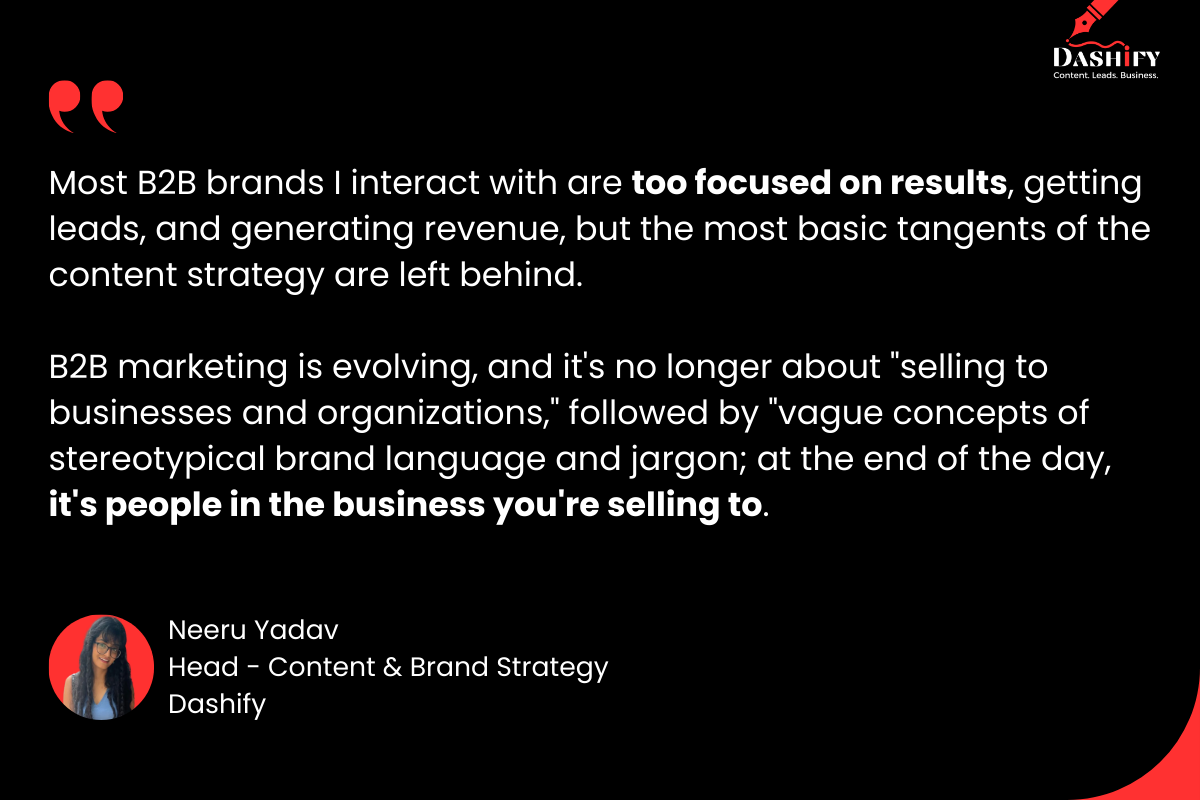
She adds, “Creating buyer personas while building a B2B content strategy is your first step to better business and better communication with your target audience.”
Action 8. Conduct Market Research
Engage in thorough market research to gain insights into industry trends, challenges, and emerging opportunities. Understand the competitive landscape and identify gaps where your content can provide unique value. Analyze competitor strategies to identify successful approaches and areas for differentiation.
Action 9. Utilize Analytics and Data
Leverage analytics tools to analyze data related to your existing audience. Understand which content performs well, audience demographics, and the channels through which they engage. Data-driven insights enable you to refine your B2B content strategy based on actual user behavior and preferences.
Action 10. Map the Buyer’s Journey
Map out the stages of the buyer’s journey within the B2B context. Identify touchpoints where your audience seeks information, makes decisions, and evaluates solutions. Align your content strategy with the different phases of this journey, delivering relevant content at each stage.
Action 11. Identify Pain Points and Challenges
Gain a deep understanding of the pain points and challenges faced by your B2B audience. Your content should provide solutions, insights, and actionable advice that directly address these pain points. This positions your brand as a valuable resource and establishes trust with your audience.
Action 12. Engage with Your Audience
Actively engage with your audience through social media, forums, and other channels. Monitor discussions, participate in relevant conversations, and solicit feedback. Direct interaction with your audience provides qualitative insights that complement quantitative data.
Action 13. Regularly Update Buyer Personas
Buyer personas are dynamic and may evolve over time. Regularly update your buyer personas based on changing market dynamics, feedback, and shifts in your audience’s behavior. This ensures that your B2B content strategy remains relevant and continues to resonate with your target audience.
Read More: The Complete Buyer Enablement Guide
Step 3: Conduct a Content Audit
Conducting a content audit is a crucial step in refining and optimizing your B2B content strategy. This process involves a comprehensive analysis of your existing content assets to assess their performance, relevance, and alignment with your strategic goals.
Why: To gain actionable insights that inform strategic decisions, enhance content effectiveness, and ensure alignment with your overarching B2B marketing objectives.
Here’s a detailed breakdown:
Action 14. Compile a Content Inventory
Begin by compiling an inventory of all your existing content assets. This includes blog posts, articles, whitepapers, case studies, videos, and any other content created across various channels. Organize this inventory in a structured manner for efficient analysis.
Action 15. Evaluate Content Relevance
Assess the relevance of each content piece in relation to your current business objectives and the needs of your target B2B audience. Identify content for digital marketing that aligns with your strategic focus and contributes meaningfully to your goals. Content that no longer serves a purpose may be flagged for revision or removal.
Action 16. Analyze Performance Metrics
Utilize analytics tools to gather quantitative data on the performance of each content asset. Key metrics include page views, engagement rates, conversion rates, and social shares. Identify high-performing content that resonates with your audience and contributes to your objectives.
Action 17. Assess SEO Effectiveness
Evaluate the SEO effectiveness of your content by analyzing keyword rankings, organic traffic, and backlink profiles. Identify opportunities to optimize content for relevant keywords and improve search engine visibility. Ensure that your content aligns with SEO best practices for increased discoverability.
Action 18. Consider Content Formats
Take note of the formats used for your content, such as blog posts, infographics, webinars, or podcasts. Assess the effectiveness of these formats in conveying your message and engaging your B2B audience. Consider diversifying content formats based on the preferences of your audience.
Action 19. Identify Content Gaps
Identify gaps in your content strategy by assessing topics or themes that are underrepresented. These gaps represent opportunities to create new content that addresses unmet needs or explores emerging trends within your industry. A well-rounded content strategy covers a diverse range of relevant topics.
Action 20. Review Brand Consistency
Ensure that your content maintains consistency in brand messaging, tone, and visual identity. A cohesive brand presence across content assets enhances brand recognition and reinforces your positioning in the B2B market. Address any inconsistencies that may dilute your brand image.
Action 21. Plan Your Repurposing Roadmap
Identify high-performing content pieces (old ones) that can be repurposed or updated to extend their lifespan. Repurposing content into different formats or adapting it for new channels allows you to maximize the value of existing assets. It also facilitates efficient content creation based on proven themes.
Action 22. Document Findings and Recommendations
Document your content audit findings, including insights, performance metrics, and recommendations. Create a roadmap for implementing changes, updating content, and developing new pieces aligned with your refined B2B content strategy.
Step 4: Keyword Research for SEO Optimization
Keyword research is a fundamental aspect of optimizing your B2B content for search engines, ensuring that it aligns with the search behavior of your target audience.
Why: To optimize your B2B content for discoverability, improve search engine rankings, and enhance the visibility of your brand within the competitive landscape.
Here’s a detailed explanation:
Action 23. Understand Your B2B Audience
Begin by understanding the language and terminology used by your B2B audience. Identify industry-specific keywords, phrases, and terms that resonate with your target customers. Consider the challenges they face and the solutions they seek, as these insights inform your keyword strategy.
Action 24. Compile a Seed Keyword List
Develop a seed keyword list that represents the core topics and themes relevant to your B2B business. These are broad terms that encapsulate your products, services, and industry focus. Use these seed keywords as a foundation for expanding your research to more specific and long-tail keywords.
Action 25. Utilize Keyword Research Tools
Leverage keyword research tools such as Google Keyword Planner, SEMrush, or Ahrefs to identify relevant keywords and assess their search volumes. These tools provide valuable insights into the popularity of keywords, competition levels, and variations that your audience may use when conducting searches.
Action 26. Focus on Long-Tail Keywords
Recognize the importance of long-tail keywords, which are more specific and typically consist of three or more words. Long-tail keywords often reflect user intent more precisely, leading to higher conversion rates. Identify long-tail variations that align with your B2B content and address specific customer needs.
Action 27. Competitor Analysis
Analyze the keywords targeted by your competitors within the B2B space. Identify gaps in their keyword strategy and areas where you can differentiate your content. This competitive analysis provides insights into industry trends, high-performing keywords, and opportunities to capture organic search traffic.
Action 28. Prioritize and Group Keywords
Prioritize your list of keywords based on relevance, search volume, and competitiveness. Group related keywords into thematic clusters to create a structured approach to content creation. This clustering enhances the coherence of your content strategy and ensures a comprehensive coverage of relevant topics.
Action 29. Consider User Intent
Understand the intent behind user searches and align your keywords with specific stages of the buyer’s journey. Keywords indicating informational intent, transactional intent, or navigational intent guide the creation of content that caters to the diverse needs of your B2B audience throughout their decision-making process.
Action 30. Integrate Keywords Naturally
As you create content, integrate selected keywords naturally into your titles, headings, body text, and meta descriptions. Ensure that the inclusion of keywords enhances the readability and value of your content. Avoid keyword stuffing, and prioritize delivering informative and engaging content.
Action 31. Monitor and Refine
Regularly monitor the performance of keywords using analytics tools. Track changes in search rankings, organic traffic, and user engagement. Refine your keyword strategy based on emerging trends, shifts in user behavior, and updates to search engine algorithms. Adapt your content to maintain optimal SEO performance.
Read More: Top 10 AI Tools for SEO
Step 5: Determine Content Formats and Channels
Determining the appropriate content formats and channels is a crucial step in crafting a successful B2B content strategy. Tailoring your content to the preferences of your target audience and selecting the right distribution channels maximize the impact of your efforts.
Why: To make your B2B content strategy a targeted and effective means of reaching and engaging your audience throughout their buyer’s journey.
Here’s a detailed explanation:
Action 32. Run Audience Analysis
Begin by revisiting your buyer personas and understanding the preferences of your B2B audience. Analyze their behavior to identify the types of content they engage with most. Consider factors such as industry trends, business challenges, and the informational needs of your audience.
Action 33. Assess Content-Format Options
Explore a variety of content formats that resonate with B2B audiences.
Common formats include:
Blog Posts: Informative articles addressing industry trends, challenges, and solutions.
Whitepapers and Ebooks: In-depth research and insights offering valuable knowledge.
Case Studies: Real-world examples showcasing your product or service’s success.
Webinars and Video Content: Engaging presentations and demonstrations.
Infographics: Visual representations of data and key concepts.
Podcasts: Audio content providing industry insights and discussions.
Interactive Content: Quizzes, assessments, and interactive tools.
Action 34. Select Channels
Identify the channels that align with your B2B audience’s preferences and behavior. Common channels include:
Company Website: Publish content on your website to establish a central hub for information.
LinkedIn: Utilize LinkedIn for professional networking, sharing articles, and participating in industry discussions.
Email Marketing: Send targeted content directly to your B2B audience through email campaigns.
Industry Forums and Communities: Engage in relevant forums to share expertise and connect with professionals.
Webinars and Virtual Events: Host online events to showcase expertise and facilitate discussions.
Social Media Platforms: Utilize platforms like Twitter and Facebook for content distribution and engagement.
Content Syndication: Partner with industry publications to reach a wider audience.
Action 35. Align with Buyer’s Journey
Tailor content formats to align with different stages of the buyer’s journey. Provide educational content for awareness, detailed insights for consideration, and actionable resources for decision-making. Map your content to the specific needs of your audience at each stage.
Action 36. Repurpose Content Across Formats and Channels
Maximize the impact of your content by repurposing it across multiple formats and channels. For example, a blog post can be adapted into an infographic, podcast episode, or included in a webinar. Decide these channels and formats on priority as repurposing ensures your message reaches diverse audiences through preferred mediums.
Action 37. Maintain Consistency and Quality
Maintain consistency in your chosen content formats and channels to establish a cohesive brand presence. Focus on delivering high-quality content that adds value to your audience. Consistency builds trust and reinforces your position as an authoritative source within the B2B space.
Action 38. Leverage Analytics and Optimization
Implement analytics tools to track the performance of your content across different formats and channels. Monitor metrics such as engagement, click-through rates, and conversion rates. Use insights gained from analytics to optimize your strategy, emphasizing formats and channels that yield the best results.
Step 6: Develop a Content Calendar
Developing a content calendar is a pivotal step in organizing and executing your B2B content strategy efficiently. A well-structured calendar ensures consistency, helps in resource allocation, and aligns content creation with overarching business goals.
Why: To consistently deliver valuable content that resonates with your B2B audience and contributes to the overall success of your marketing efforts.
Here’s an in-depth explanation:
Action 39. Define Content Objectives
Begin by clearly outlining the objectives your content aims to achieve. Whether it’s increasing brand awareness, generating leads, or nurturing customer relationships, align each piece of content with specific goals.
Action 40. Understand the Buyer’s Journey
Map out the stages of the buyer’s journey—awareness, consideration, and decision-making. Tailor your content calendar to deliver the right content at the right time, addressing the informational needs of your audience at each stage.
Action 41. Identify Key Themes and Topics
Determine the overarching themes and topics that resonate with your B2B audience. These should align with your business expertise, industry trends, and the challenges faced by your target customers. Focus on providing valuable insights and solutions.
Action 42. Specify Content Formats and Variations
Specify the content formats for each piece, such as blog posts, whitepapers, webinars, or case studies. Incorporate variations within these formats to keep your content diverse and engaging. For instance, a series of blog posts could explore different facets of a central theme.
Action 43. Perform Keyword Integration for SEO
Infuse relevant keywords into your content calendar to optimize it for search engines. Conduct thorough keyword research to identify terms that align with your industry and resonate with your target audience. Integrate these keywords strategically across your content plan.
Action 44. Establish a Publishing Schedule
Determine the frequency of your content publication. Whether it’s a weekly blog post, monthly webinar, or quarterly whitepaper, establish a consistent publishing schedule. This helps in maintaining regular engagement with your audience and sets expectations.
Action 45. Allocate Resources
Clearly define roles and responsibilities within your team. Allocate resources for content creation, editing, design, and promotion. Ensure that each team member understands their role in executing the content calendar efficiently.
Action 46. Include Seasonal and Timely Content
Incorporate seasonal or timely content that aligns with industry events, holidays, or relevant trends. This adds a dynamic element to your calendar and keeps your content fresh and relevant.
Action 47. Build Content Promotion Plan
Develop a plan for promoting each piece of content. Identify the channels—social media, email, industry forums—through which you’ll distribute your content. Craft engaging promotional messages tailored to each platform.
Action 48. Review and Adapt
Regularly review the performance of your content against predefined goals. Analyze metrics such as engagement, traffic, and conversions. Use insights to adapt and refine your content calendar, ensuring continuous improvement.
Action 49. Integration with Marketing Campaigns
Integrate your content calendar with broader marketing campaigns. Ensure that content supports the overarching marketing strategy, contributing to the achievement of business objectives.
Action 50. Mark Future Content-Repurposing Opportunities
Identify opportunities for repurposing content across different channels. For instance, your latest webinar can be repurposed into blog posts, infographics, or social media snippets. Maximize the reach and impact of your content through extensive repurposing.
Step 7: Craft High-Quality and Valuable Content
Crafting high-quality and valuable content is the essence of a successful B2B content strategy. Your content should not only capture the attention of your audience but also provide meaningful insights and solutions.
Why: To lay the foundation for a robust and effective content strategy. Each piece of content should contribute to building trust, authority, and lasting relationships with your target audience.
Here’s a detailed explanation:
Action 51. Understand Your Audience’s Pain Points
Before diving into content creation, have a deep understanding of your B2B audience. Know their pain points, challenges, and informational needs. Tailor your content to address these specific aspects, demonstrating a profound understanding of your audience’s concerns.
Action 52. Align with Business Objectives
Ensure that each piece of content aligns with your overarching business objectives. Whether it’s lead generation, brand awareness, or thought leadership, every content asset should contribute directly to the achievement of these goals.
Action 53. Focus on Relevance and Value
Prioritize relevance and value in your content. Address industry trends, challenges, and emerging topics. Provide actionable insights and solutions that your audience can apply in their professional roles. The more value your content delivers, the more credibility you build.
Action 54. Maintain a Consistent Brand Voice
Develop and maintain a consistent brand voice across all content assets. This includes blogs, whitepapers, videos, and any other format you choose. Consistency in tone and messaging helps in establishing a recognizable brand identity.
Action 55. Use Clear and Concise Language
B2B audiences appreciate clarity. Use clear and concise language to convey your message. Avoid unnecessary jargon or complex terminology unless your audience is highly specialized and expects it. Aim for simplicity without sacrificing depth.
Action 56. Employ Storytelling Techniques
Integrate storytelling techniques into your content. Narratives resonate with audiences and create a more engaging experience. Share real-world examples, case studies, or success stories that illustrate the impact of your products or services.
Action 57. Optimize for Readability
Ensure that your content is easy to read and digest. Break down lengthy paragraphs and use subheadings, bullet points, and visuals to enhance readability. B2B professionals often have limited time, so make it effortless for them to extract valuable insights.
Action 58. Incorporate Visual Elements
Visual elements such as infographics, charts, and images enhance the visual appeal of your content. They serve as valuable aids in conveying complex information. Visuals break up the text and make the content more engaging, like the ones in this blog!
Action 59. Provide Actionable Takeaways
Conclude your content with actionable takeaways. Summarize key points and provide readers with clear steps or recommendations they can implement in their business strategies. This adds practical value to your content.
Action 60. Include Credible References
Back your statements with credible references and data. B2B professionals rely on accurate information. When you incorporate statistics, studies, or quotes from industry experts, it enhances the credibility of your content.
Action 61. Encourage Engagement and Discussion
Foster engagement by encouraging comments, discussions, and sharing. Pose questions to your audience, seek their opinions, and create a space for meaningful interactions. Respond promptly to comments to build a sense of community.
Action 62. Drive Continuous Improvement Through Analytics
Regularly analyze content performance through analytics. Track metrics such as engagement, time on page, and conversion rates. Use insights to identify successful content elements and areas for improvement. Iterate and refine your content strategy based on data-driven decisions.
Step 8: Implement a Distribution Strategy
Implementing a distribution strategy is crucial to ensure that your carefully crafted B2B content reaches its intended audience effectively.
Why: To maximize the impact of your B2B content, ensuring it reaches the right audience across various channels. The goal is to create a cohesive and integrated approach that leverages each distribution channel’s strengths for optimal results.
Here’s a detailed explanation:
Action 63. Identify Target Channels for Content Distribution
Begin by identifying the most relevant channels for distributing your B2B content. Consider platforms where your target audience is active. This may include industry-specific forums, social media platforms, email newsletters, and professional networks.
Action 64. Leverage Social Media Platforms for Content Marketing
Utilize social media platforms strategically. Share your content across channels like LinkedIn, Twitter, and relevant industry groups. Craft compelling social media captions that prompt engagement and encourage sharing. Tailor your approach to each platform’s unique characteristics.
Action 65. Launch Email Marketing Campaigns
Incorporate your content into email marketing campaigns. Segment your email lists based on audience preferences and tailor content accordingly. Leverage email newsletters to provide valuable insights, industry updates, and links to your in-depth content pieces.
Action 66. Collaborate with Influencers
Identify key influencers within your industry and collaborate with them to amplify your content. Influencers can extend your reach by sharing your content with their established audiences, providing additional credibility and visibility.
Action 67. Syndicate Your Business Content
Explore content syndication opportunities with reputable platforms in your industry. Syndicating your content allows it to be republished on authoritative websites, reaching a broader audience. Ensure that syndication agreements align with your content distribution goals.
Action 68. Run Paid Advertisements
Invest in paid advertising to boost the visibility of your B2B content. Platforms like LinkedIn Ads and sponsored content on industry-specific websites can target your content to professionals who match your ideal audience criteria.
Action 69. Encourage Employee Advocacy
Activate your internal team as advocates for your content. Encourage employees to share content on their personal and professional networks. This not only expands reach but also adds a human touch to your brand, increasing authenticity.
Action 70. Announce and Conduct Webinars and Virtual Events
Host webinars or participate in virtual events where you can showcase your content. Engage with your audience in real time, answer questions, and provide additional context to your content. Webinars offer an interactive and dynamic way to share insights.
Action 71. Revamp and Re-Optimize for Search Engines
Ensure that your content is optimized for search engines (SEO) at all times. Keep updating your content regularly and implement relevant keywords, meta tags, and descriptions. This enhances the likelihood of your content appearing or holding its place in organic search results, increasing its discoverability.
Action 72. Repurpose Your Repurposed Content Again Across Channels
Repurpose your content in different formats for diverse channels. For instance, transform a repurposed blog post into a new slide deck for sharing on SlideShare or repurpose key insights into visually appealing infographics for social media.
PS. Don’t get confused with the multiple actions related to content repurposing. Let’s simplify it for you:
- [Action 21] Plan what, where, and how to repurpose
- [Action 36] Start repurposing existing content for the first time
- [Action 50] Look for new opportunities for content repurposing
- [This One] Use repurposed content to churn out fresh content further
Action 73. Track Channel Performance
Regularly monitor the performance of your distribution channels. Track metrics such as click-through rates, engagement, and conversions. Use analytics tools to gain insights into which channels are most effective. Adjust your distribution strategy based on data-driven observations.
Action 74. Engage in Industry Forums
Participate in industry forums and discussion groups relevant to your niche. Share your expertise by contributing valuable insights and linking to your content when appropriate. Forums provide an opportunity to engage directly with professionals interested in your industry.
Action 75. Build Partnerships
Collaborate with industry partners to expand your content reach. Explore co-marketing opportunities where you can cross-promote each other’s content to benefit from extended visibility within your shared target audience mutually.
Step 9: Monitor and Analyze Performance Metrics
Monitoring and analyzing performance metrics are integral components of refining your B2B content strategy for optimal results.
Why: To empower your B2B content strategy with data-driven insights, allowing for continuous optimization and improvement. The iterative nature of this step ensures that your content strategy remains agile and responsive to changing dynamics in the market.
Here’s a detailed explanation:
Action 76. Define Key Performance Indicators (KPIs)
Start by defining specific Key Performance Indicators (KPIs) aligned with your content marketing goals. Common KPIs include website traffic, engagement metrics (likes, shares, comments), conversion rates, lead generation, and ROI. Tailor your KPIs to reflect the desired outcomes of your content strategy.
Action 77. Utilize Analytics Tools
Employ robust analytics tools to gather data on the performance of your B2B content. Platforms like Google Analytics, social media insights, and email marketing analytics provide valuable insights. Track user behavior, referral sources, and audience demographics to understand how your content resonates.
Action 78. Regularly Review Metrics
Establish a regular cadence for reviewing performance metrics. This could be a weekly, monthly, or quarterly assessment, depending on your content release frequency. Regular reviews allow you to identify trends, spot anomalies, and make timely adjustments to your strategy.
Action 79. Assess Engagement Metrics
Dive deep into engagement metrics to understand how your audience interacts with your content. Analyze likes, shares, comments, and social media engagement rates. Identify content pieces that resonate the most and replicate successful elements in future creations.
Action 80. Evaluate Conversion Rates of All the Content Assets
Assess conversion rates to measure the effectiveness of your content assets in driving desired actions. Track how many leads are generated through content, including form submissions, email sign-ups, or other conversion events. Identify high-converting content and optimize accordingly.
Action 81. Segment Performance Data
Segment performance data is based on different variables, such as audience segments, content types, and distribution channels. This segmentation provides nuanced insights into which segments are responding positively and where adjustments are needed.
Action 82. Identify and Star-Mark Top-Performing Content to Improve
Identify the top-performing content pieces based on predetermined KPIs. Pinpoint the factors contributing to their success, whether it’s the format, topic, or distribution channel. Leverage this insight to inform future content creation.
Action 83. Track User Journey
Follow the user journey from content discovery to conversion. Understand the pathways users take through your website and content. Identify any bottlenecks or drop-off points in the user journey and optimize the content or user experience accordingly.
Action 84. A/B Testing
Implement A/B testing for elements like headlines, calls-to-action, or content formats. This allows you to experiment with different variations and identify what resonates best with your audience. A/B testing provides actionable insights for refining content strategies.
Action 85. Evaluate SEO Performance
Assess the SEO performance of your content. Monitor keyword rankings, organic search traffic, and backlink acquisition. Optimize content based on SEO insights to enhance visibility in search engine results.
Action 86. Gather Customer Feedback
Gather customer feedback through surveys, comments, and direct interactions. Customer insights provide qualitative data on how your content is perceived and whether it addresses their needs. Use feedback to refine content messaging and relevance.
Action 87. Benchmark Against Your Goals
Benchmark your performance metrics against the goals set in the initial stages of your content strategy. Evaluate whether you’re on track to achieve your objectives and make adjustments if needed.
Action 88. Execute Iterative Improvements and Improvisations
Embrace an iterative approach to content strategy improvement. Use the data gathered to make informed adjustments, experiment with new ideas, and continuously enhance your content strategy based on evolving audience preferences and industry trends.
B2B Content Examples for Marketing
Here are the best B2B content examples to take inspiration from:
B2B Blog
The Semrush Blog is the best B2B content example of well-categorized articles across relevant niches. It also offers the dark mode option for a better user experience! Take a look:
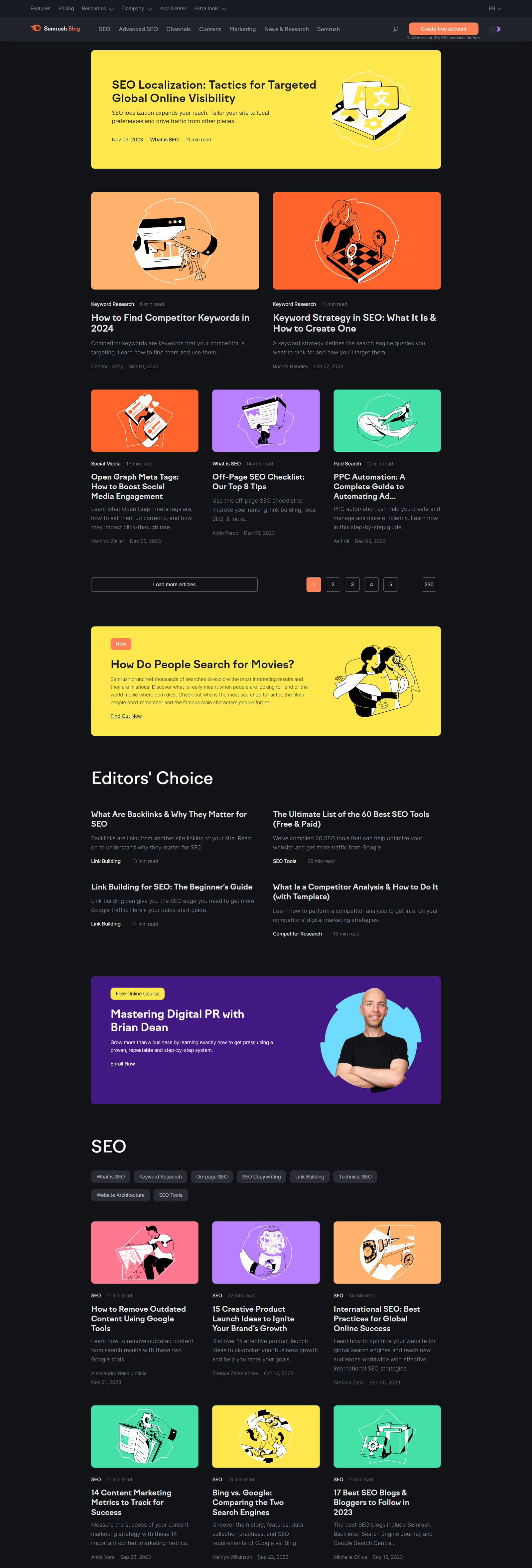
And then there’s the HubSpot Blog which also offers a dropdown menu for the users to choose a topic:
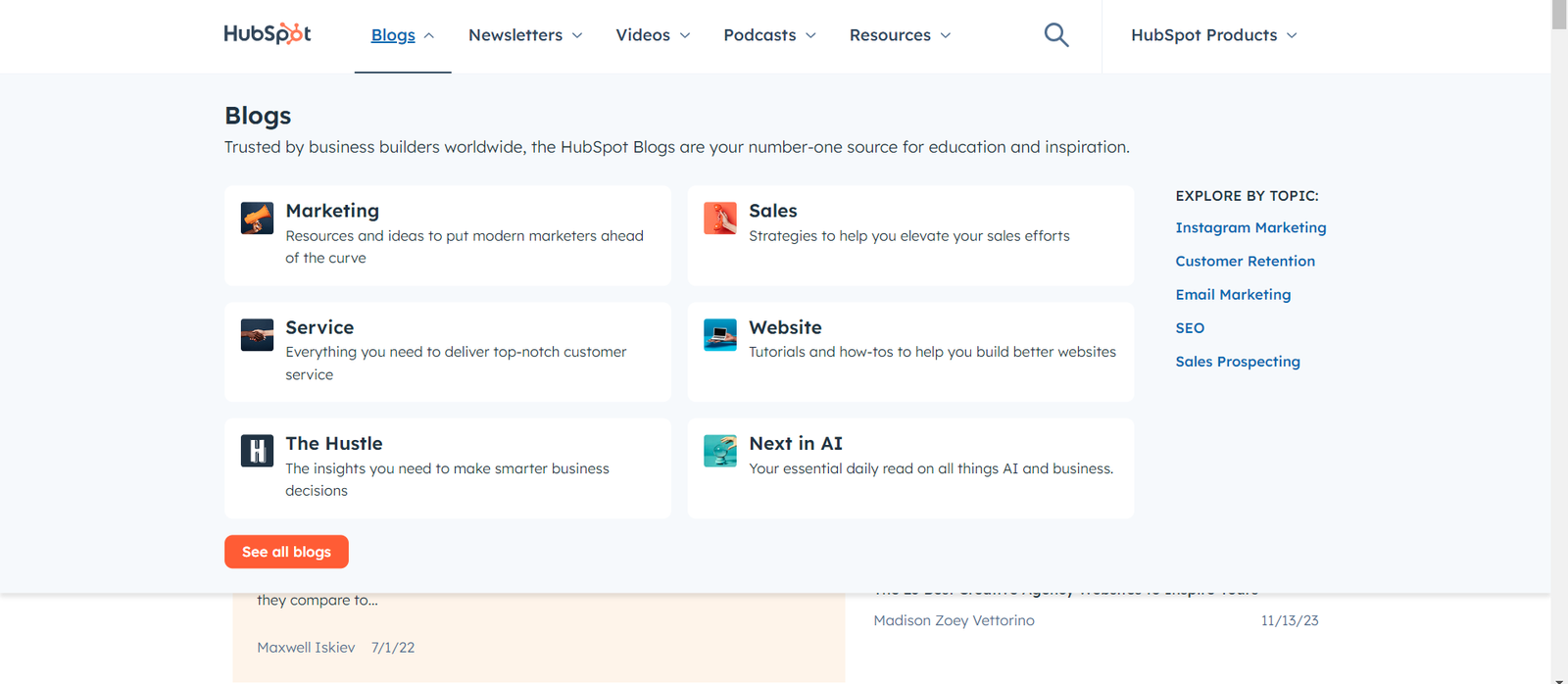
B2B Newsletters
One of the most loved B2B newsletters is the Buying Bottlenecks by Storylane:
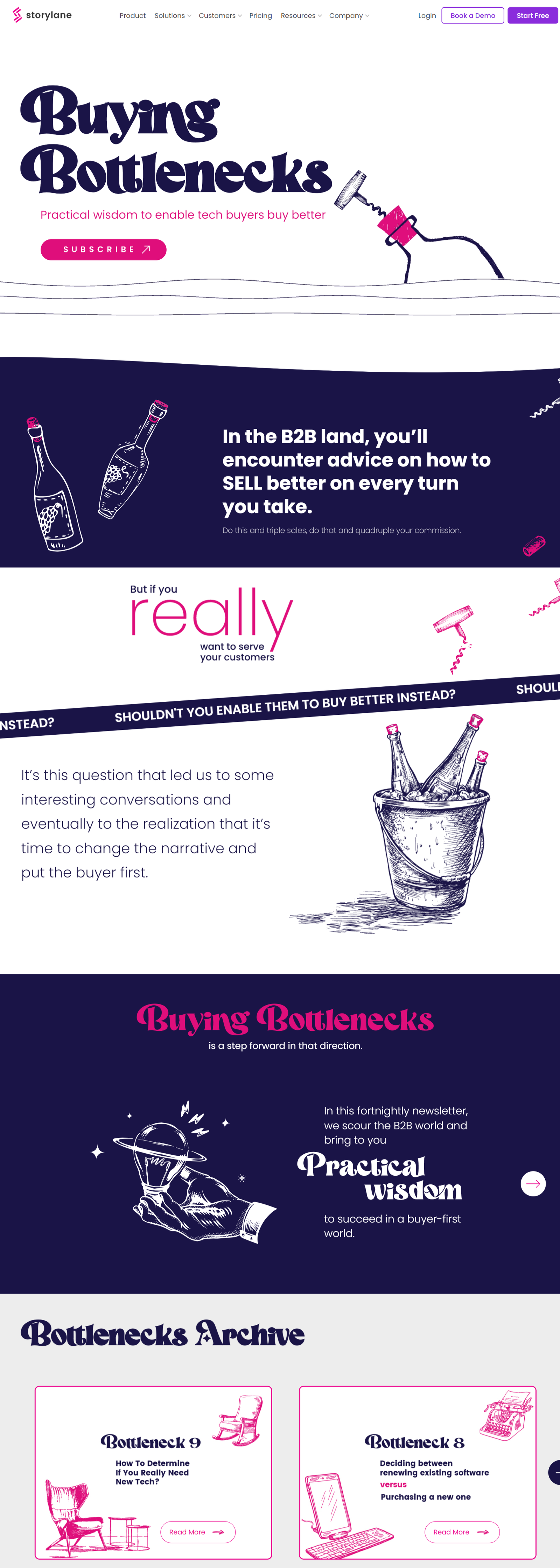
Here’s a sneak peek into one of its newsletters:
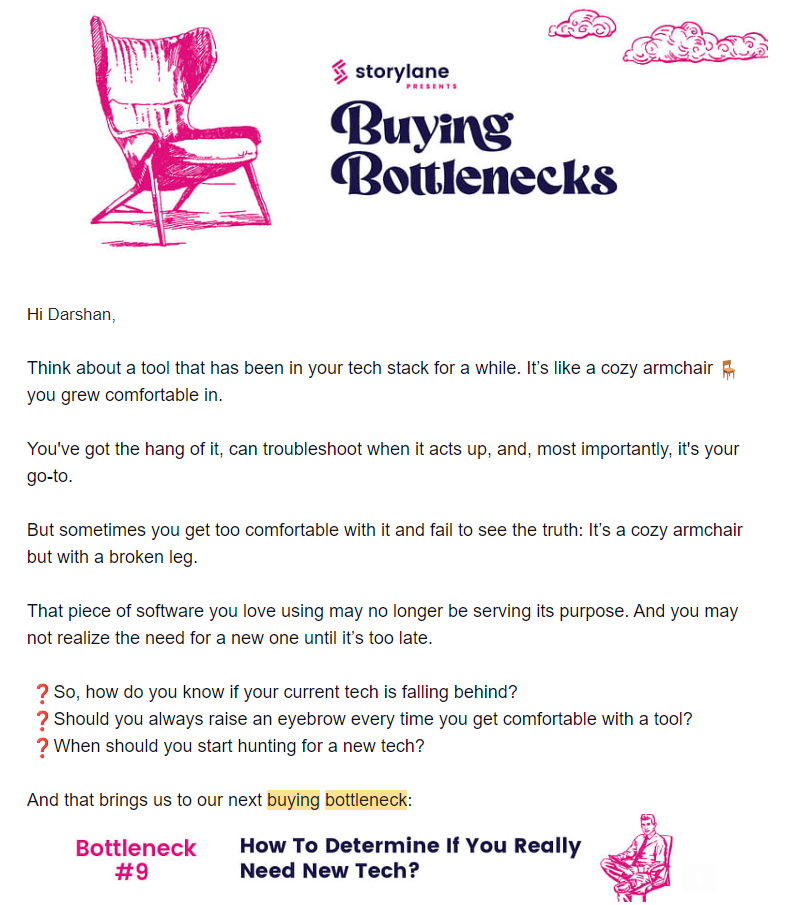
B2B Ebooks and Whitepapers
Hurix Digital publishes some of the most valuable B2B ebooks:
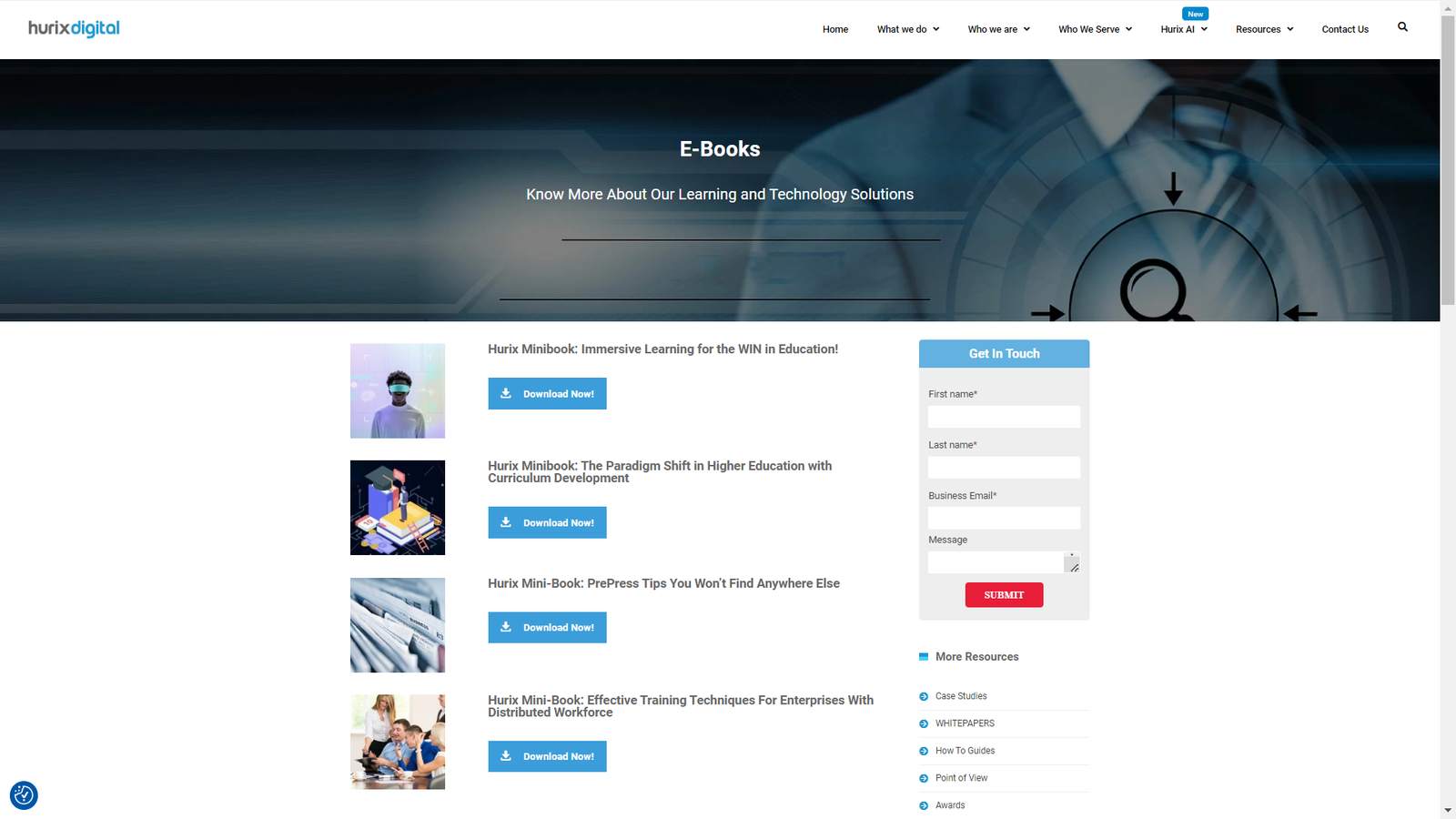
Here are its B2B whitepapers.
B2B Video Content and Webinars
PriceLabs and its product update webinars:
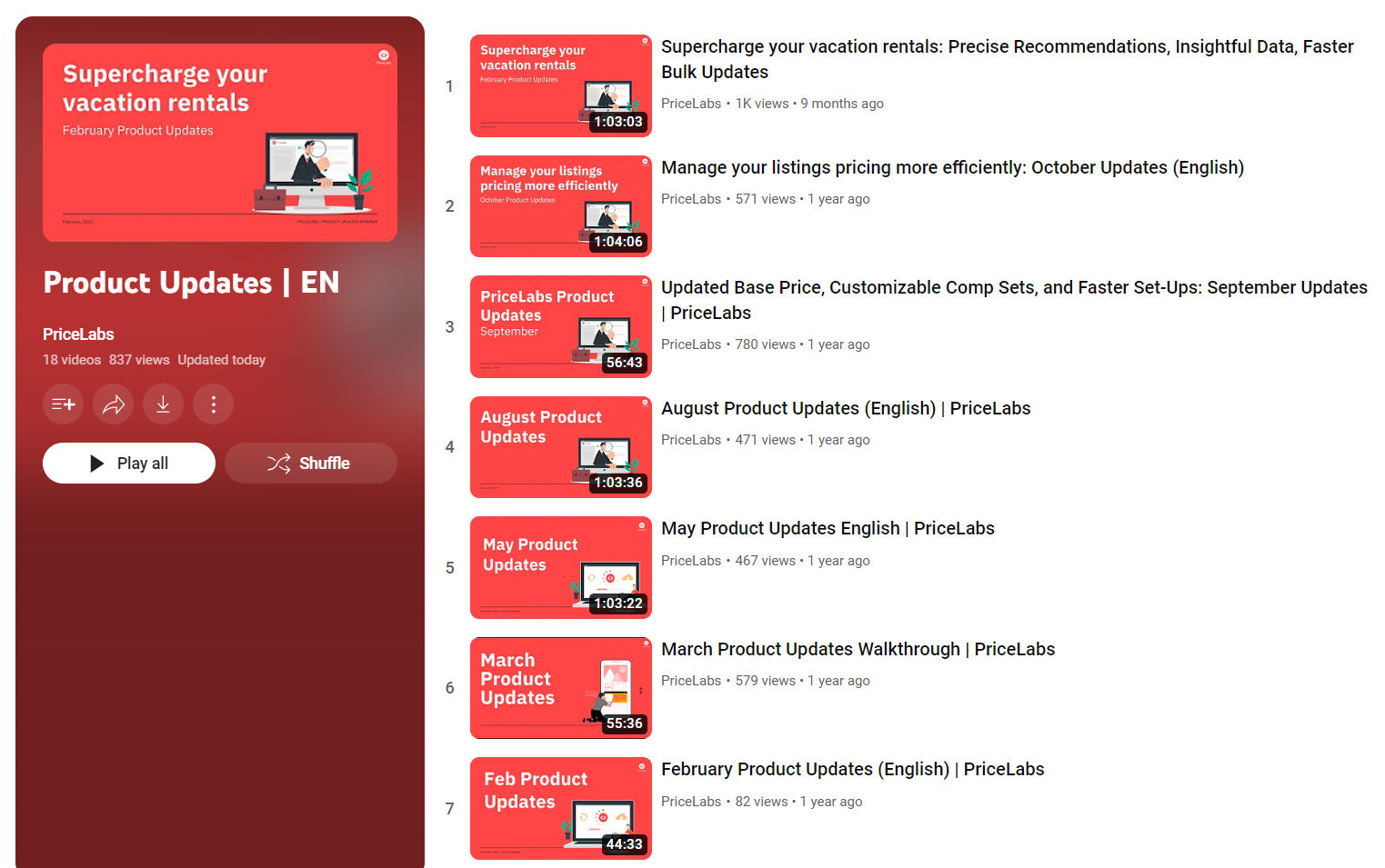
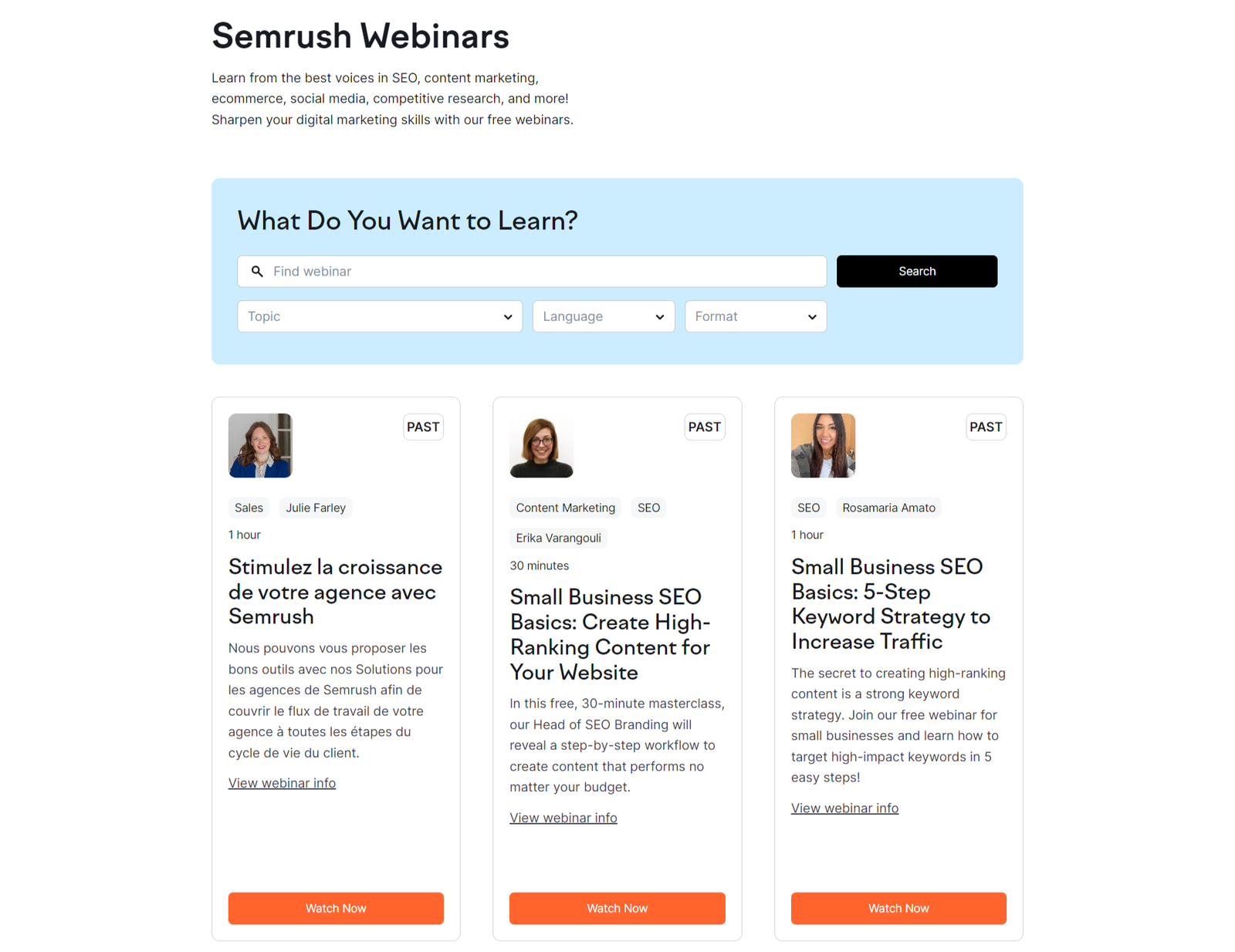
B2B Knowledge Base and Guides
Ahrefs SEO Guide:
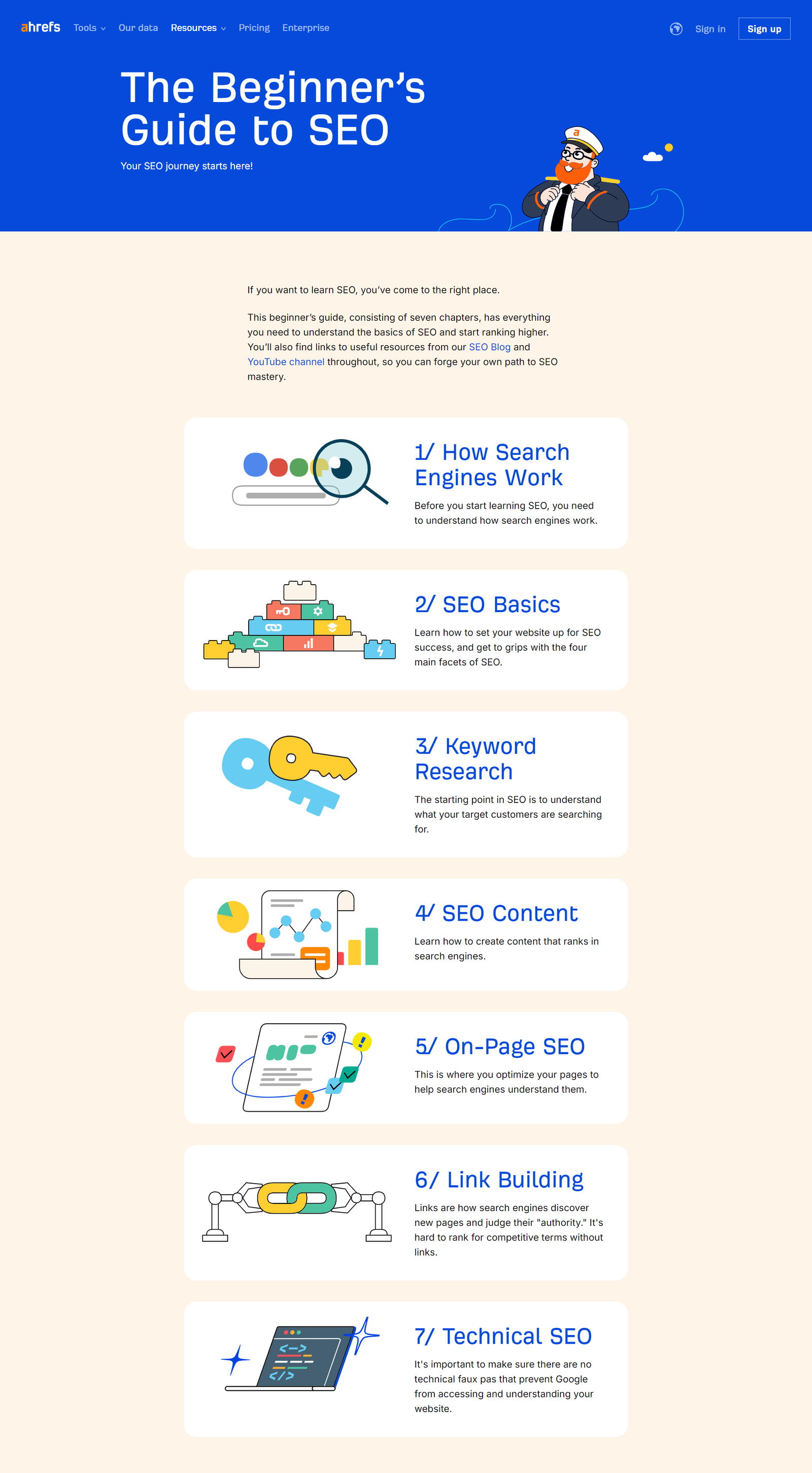
B2B Demo Centers and Tutorials
Slack’s interactive demo center lets users jump to the feature or step they want to see or know about:
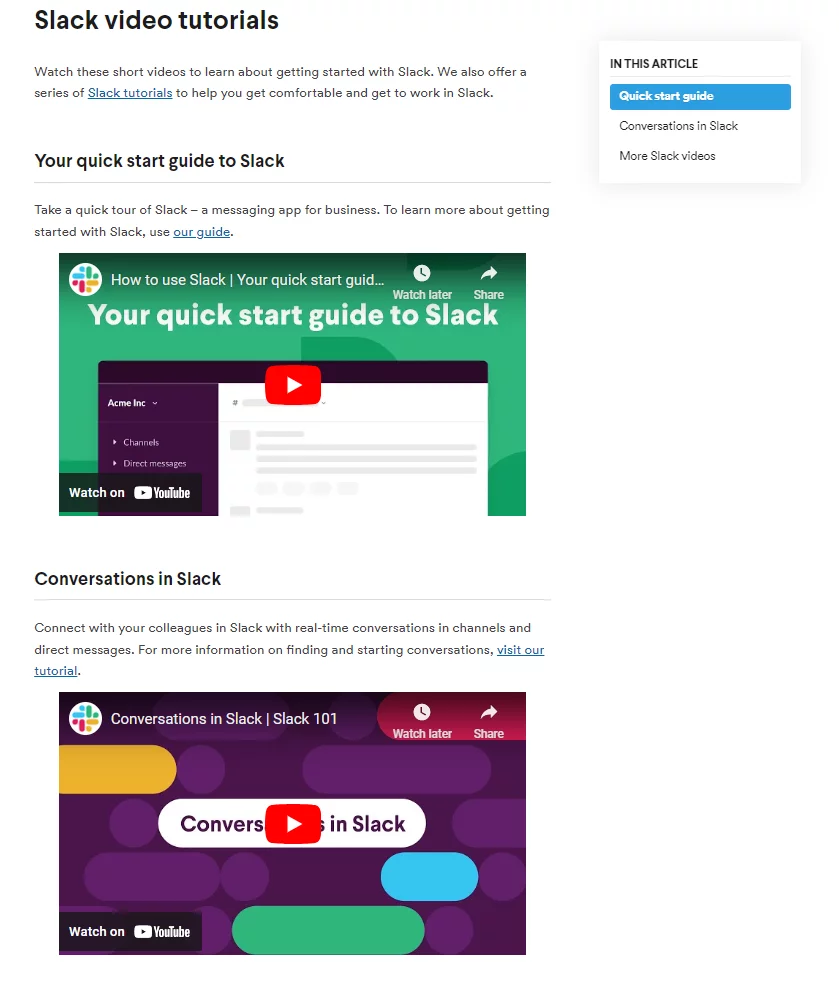
B2B Customer Showcase
Storylane takes B2B content marketing to the next level with its Customer Showcase, which shows how its SaaS product is used by its customers. Take a look:
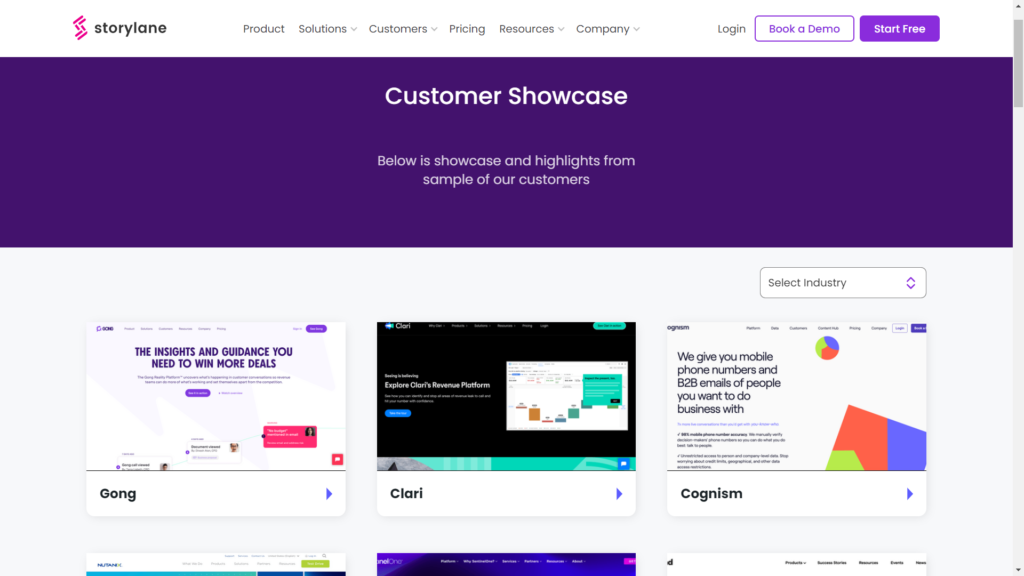
B2B Customer Stories and Case Studies
Talk about proof of work merged with user-generated B2B content, and Storylane again tops the list with its customer stories:
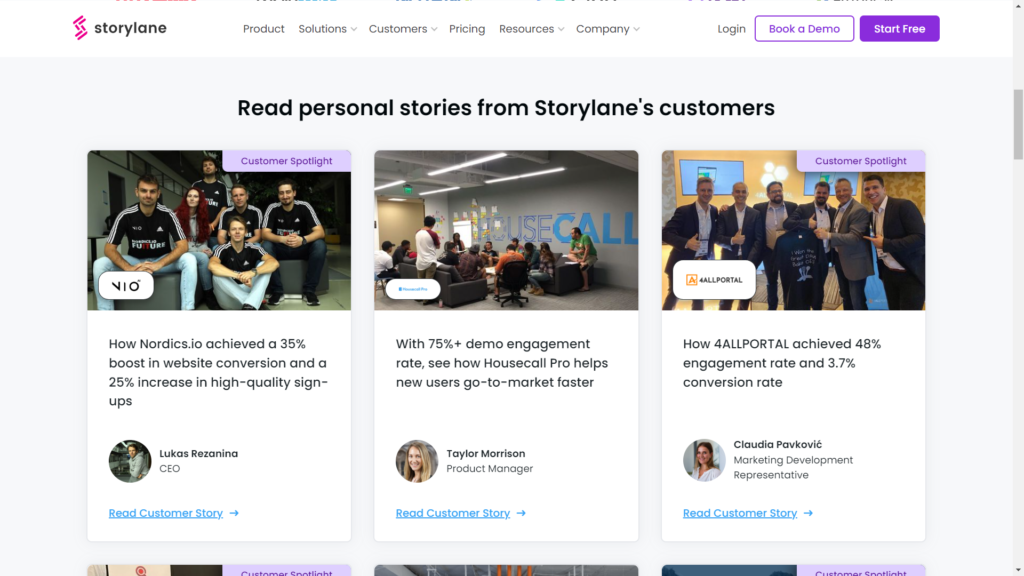
B2B Social Media Content
One of our personal favorites, this LinkedIn post by Chili Piper is the perfect example of how brands should approach B2B content strategy for social media:
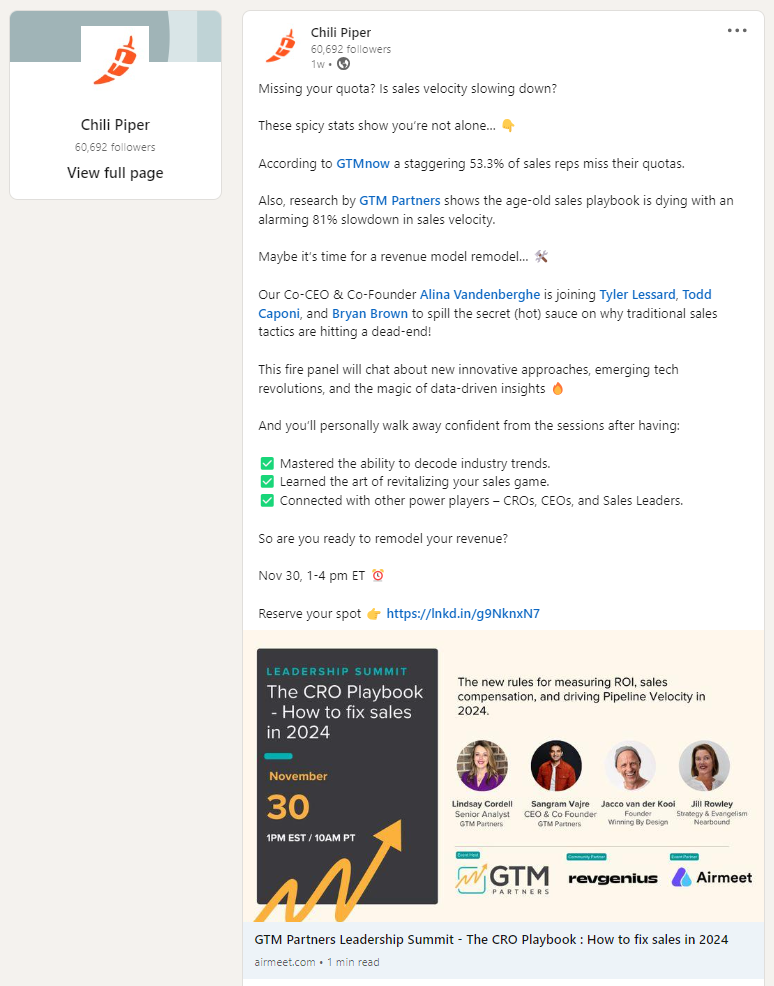
B2B Guest Posts
Here’s an example of a B2B guest post that garnered decent results for Hurix Digital:
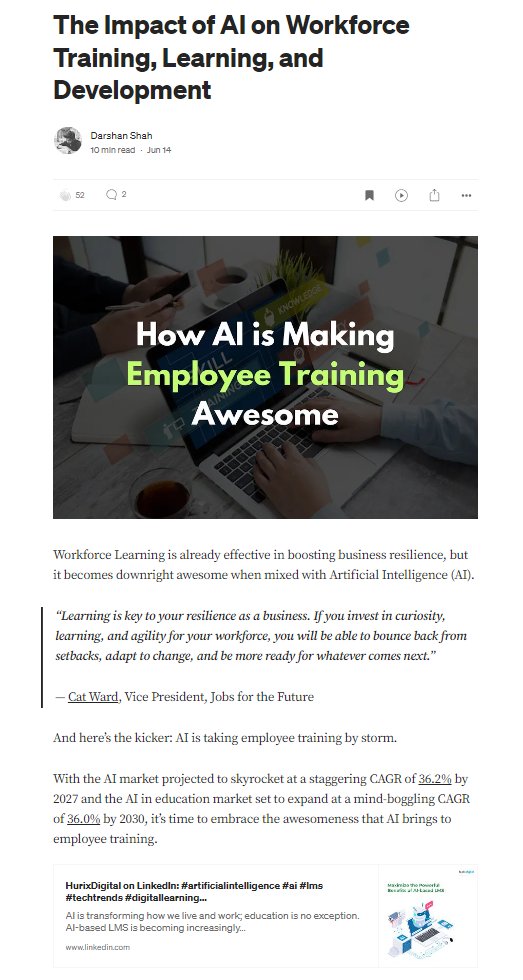
The results:
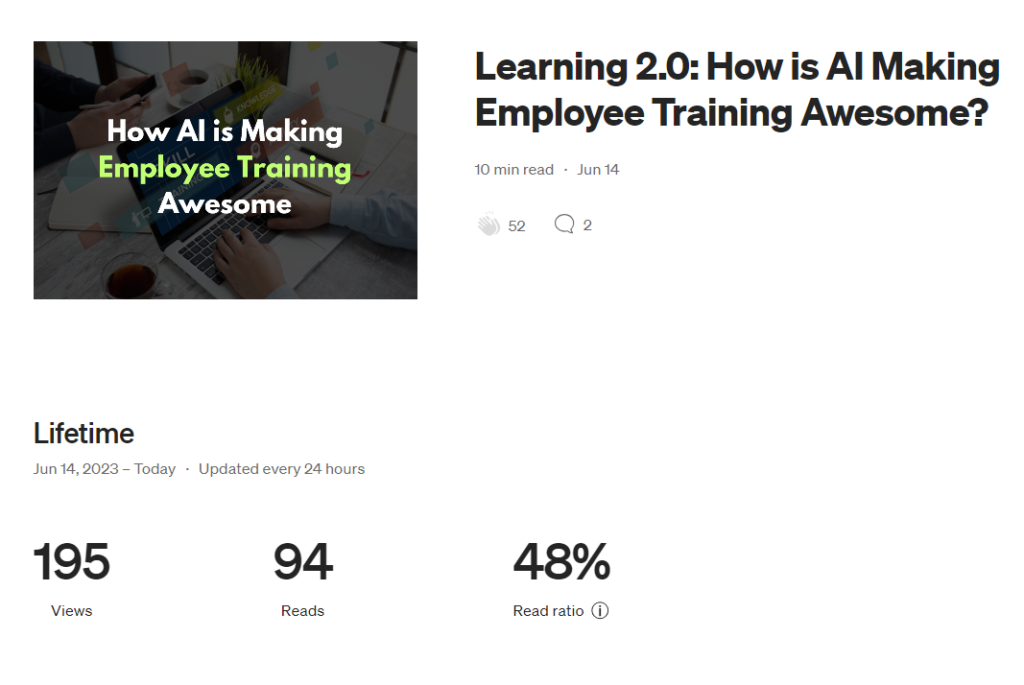
B2B Reports and Insights
Here’s Clootrack with its B2B report and insights on customer experience across industries:
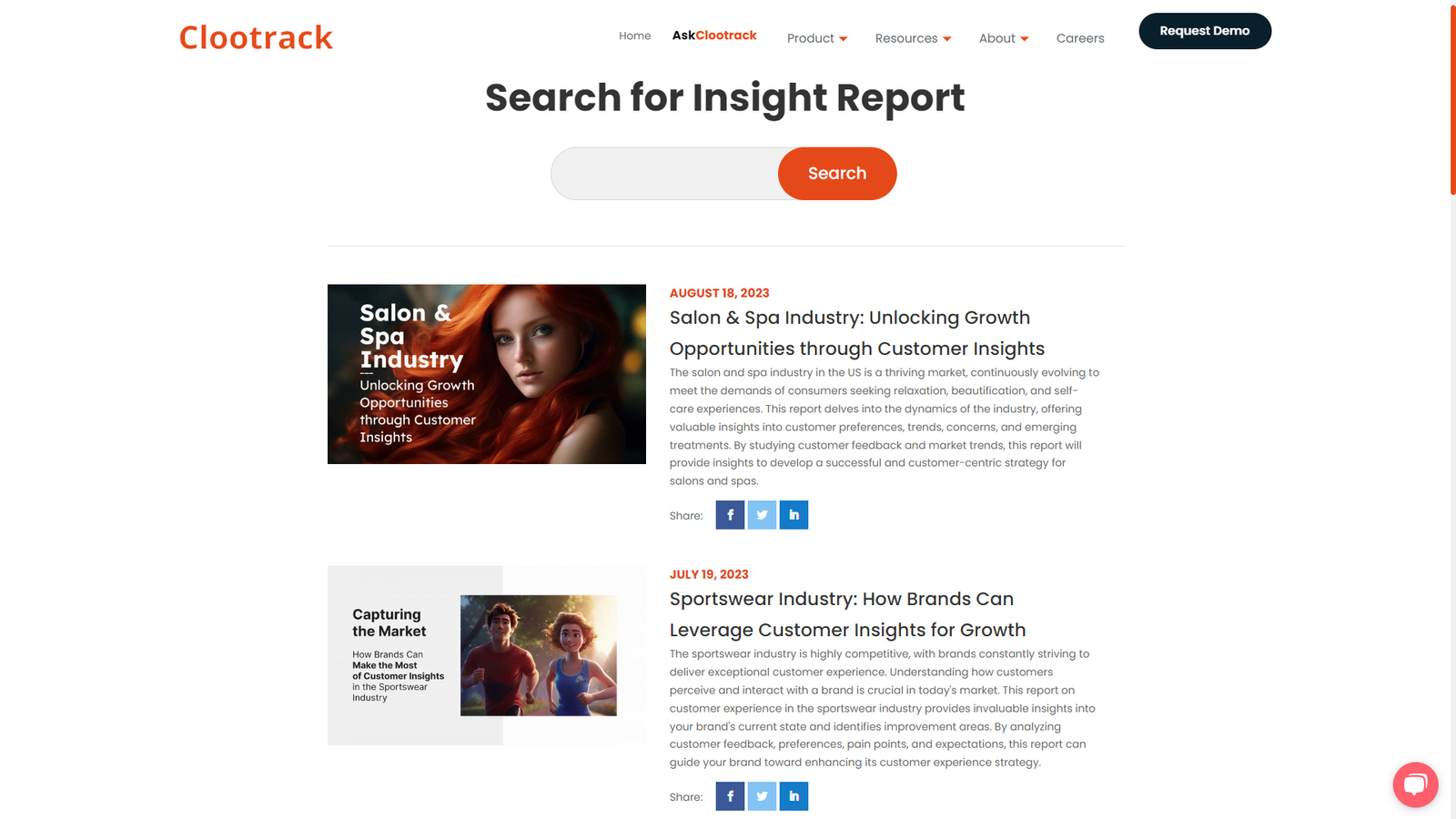
And then there’s Semrush with its data and insights:
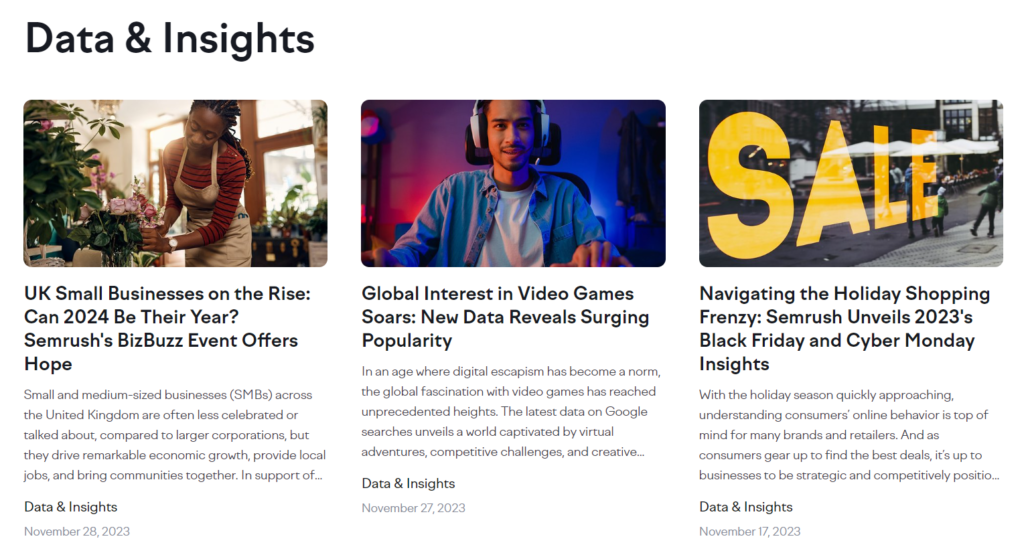
B2B Infographics
Take a look at this infographic example designed and compiled by Dashify:
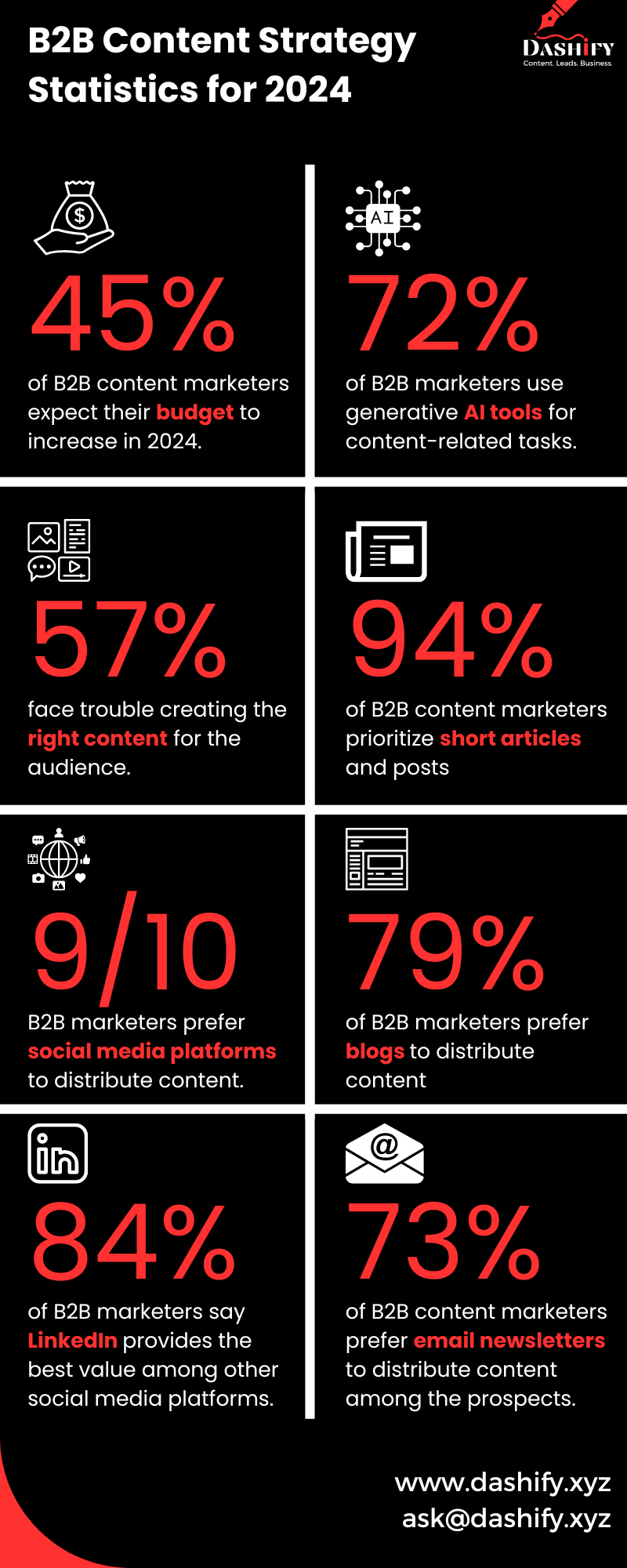
Frequently Asked Questions
Here are the answers you’re looking for!
What is B2B content?
B2B content refers to content created for Business-to-Business (B2B) marketing, targeting other businesses as the audience. It includes informative and valuable materials like articles, whitepapers, case studies, and videos designed to address the needs and challenges of businesses, showcasing products or services with the aim of driving business partnerships, collaborations, or transactions.
What are the different types of B2B content?
The different types of B2B content include blog posts, infographics, videos, podcasts, social media content, ebooks, and case studies. These formats serve to convey information, showcase expertise, and engage businesses in a variety of ways, catering to diverse preferences and needs within the B2B audience.
What’s the difference between B2C and B2B content strategy?
The difference between B2C and B2B content strategy lies primarily in the target audience. B2C content strategy focuses on individual consumers, while B2B content strategy often involves marketing to multiple individuals within a business before reaching the final decision-makers.
What’s the difference between content strategy and content marketing?
Content strategy means the planning, development, and management of content, encompassing various aspects like ideation, creation, editorial planning, and system oversight. On the other hand, content marketing means promoting and distributing content to reach and engage a target audience, aligning with marketing goals and driving conversions.
How much time does it take to create a content strategy?
The time required to create a content strategy varies based on factors such as the complexity of the strategy, the depth of research needed, and the scale of the content plan. Generally, it can take several weeks to a few months to develop a comprehensive B2B content strategy that aligns with business goals, targets the right audience, and incorporates essential elements like keyword research, content formats, and distribution plans.
Dashify Your B2B Content Strategy in 2024
From content calendars with keyword strategies to streamlined content creation processes with well-defined personas, workflows, and editorial guidelines, we’ve got you covered.
- Explore various content formats, types, and styles for different stages of your sales and marketing funnels.
- Determine the frequency, timelines, and workflow for publishing content across channels.
Make your content reach the right places, from onsite clusters and knowledge bases to offsite PR magazines, high-DA guest blogging sites, and popular social media platforms.
Target your ideal audience, attract quality leads, nurture them, and convert through Dashify’s content strategy services.
Want such detailed blogs and content assets for your business? Place your order here.


